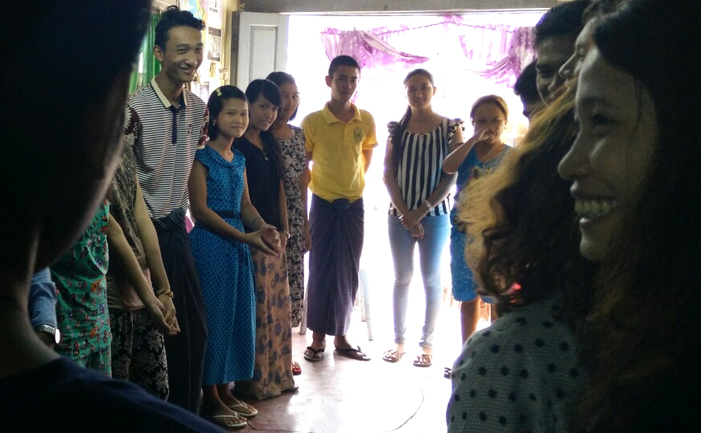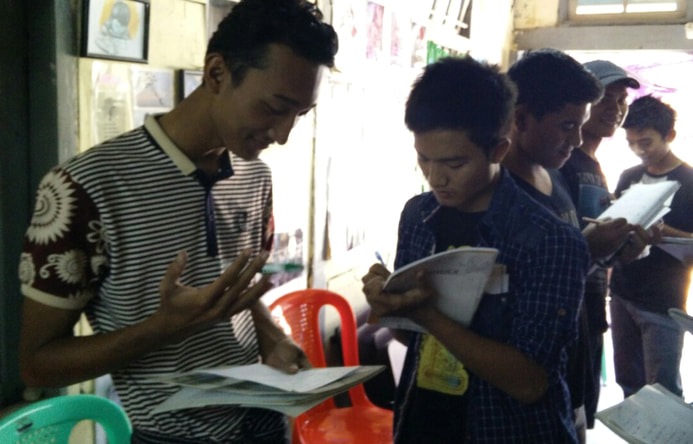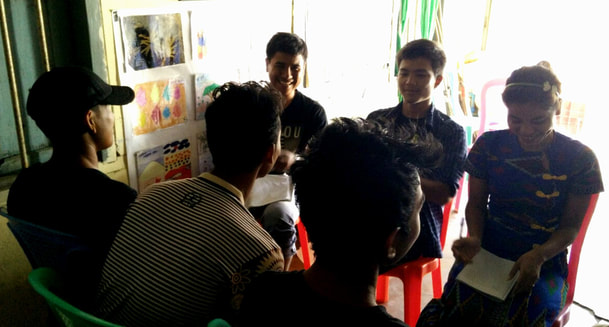|
On Friday, I began my teacher training at CEAL: The Center for Education, Arts and Literature in Sittwe. Many of the students had been away for the full moon day to nearby villages and so I was unsure of what numbers to expect. I had 8 students in total, two of whom speak great English and two of whom I hadn’t previously met. I am expecting some fluctuation in this number over the coming days; it seems hard to retain students and to specify that turning up to all classes is necessary here in Myanmar. The same is true of teachers; on Monday the students were supposed to attend a social science class but the teacher simply failed to arrive for undisclosed reasons. This behavior is new to me, and I can’t pretend to like it very much. We started with the circle introduction game; it’s the best way that I have found to learn the names of a class and it helps focus on the target language of possessive pronouns and the tricky 3rd person singular ’s’ at the end of present simple verbs. Sometimes students find it very basic and question the validity of such an exercise, but they always list more advantages than disadvantages to it. Also, it is a useful filler for any classroom and can be very easily adapted to suit different levels of learners. It requires the use of motor skills as well as speaking and listening skills; by using the physical act of throwing, people are more likely to be able to remember what came out of their mouth. After a teacher-led circle, I tasked the students to come up with their own Target Language to use in such an activity. I am still surprised at how grammar-based the curriculum is here, with students telling me that the present perfect continuous tense is taught at pre-intermediate level! Perhaps that is when it is introduced, not when it is mastered. Next we moved to the classic ‘Find Someone Who’ activity. With precious few resources available in this remote area, this is another language tool which can be quickly employed without the need for books, handouts or Powerpoint presentations. The students listed the instructional steps and then created their own sentences based on a topic of my choosing. This was linked to memories of good and bad teachers that they have had in previous classes. This is a useful exercise because it focuses new teachers on the qualities that they themselves want to achieve as a teacher. The final concept that was introduced today was the 80/20 split of teacher talking time and student talking time; that is to say that your students should be using 80% of class time to do activities while instructions and explanations should be limited to around 20% of the time. In a one hour lesson this equates to 12 minutes of teacher talking time and 48 minutes of student activity. Overall the class was orderly and efficient. Of course at this stage, it is always hard to tell how much the students are processing in order to apply. Last time, while training in Yangon, I was dismayed to realize that some of the students still felt that fun was for children and adults needed hardcore, rigorous training on the penultimate weekend. For the second day of teacher training, I had a total of 10 students. I had decided that a wild variation in levels would make it hard for me to actually focus on the technical side of training; people will not be able to teach English well if they cannot speak it. While they may have a lot of natural teaching talent, or be very receptive to learning methodology, they need to be at least one level higher than the students they are proposing to teach. I want to split this group of students, and separate those who have good English and can benefit from strict Teacher Training mixed with lesson observation and teaching practice. I am hoping that I can form a small core of students who have teaching ability, and train them thoroughly. I also hope to be able to teach other courses which are only English language. I want for the core training group to watch each other’s classes and give feedback about what was good and where there is room for improvement. Asking why a teacher did what he/she did is just as important as critiquing the lesson. Often teachers will know that they made an error of judgment, and know that they need to change, but might not be certain about what would actually work better. In the second of the classes I taught, I had a higher mean level of English, including the teacher of the Buddhist Philosophy class that I observed. He explained to me that he used to teach at CEAL, but now has a job as a translator for a well-known NGO. He gave me the impression that at least part of the reason that he gave up English teaching is because it hadn’t gone as well as he had hoped and he was rather discouraged. However, he now has renewed motivation and I sincerely hope that teacher training can encourage him to return to teaching as he has a great level of English and would be very valuable as a teacher.
I was able to do a practice activity and then task the students to fit this activity into a lesson framework. The next stage is to get them to actually practice teaching the activities that they are coming up with. I found myself impressed with the ingenuity that one group showed in thinking up their activity: a short story stuck onto the wall. One student comes and reads the story and then describes what they can remember to their partner who draws the scene. Then both partners return to the story and check the drawing against it. This is a more controlled activity than the demonstration I had provided, and an activity that would work well as the second part of a classic Present Practice Produce method of introducing language. While my example would complete the 'produce' part as it was a much more free use of the target language. One thing which seems especially important with this group of learners is that I link the language teaching to the real world through transferable skills. The other crucial thing which I don’t think that our new students fully grasp yet is the logical transition from the target language being presented in a very controlled manner through to practice and production with more freedom until the only control that the teacher has is the setting of the subject matter. You simply cannot expect students to be able to create their own sentences using their own words as the first activity you do with new language. Unless of course, you are employing the Test Teach Test method of instruction. I am happier with the second lesson than the first. Tomorrow I have a one-to-one session with the lead teacher to create a curriculum for the English course that he teaches at CEAL. I am excited about the prospect. Chloe Smith NEH Coordinator and Teacher Trainer
Comments
|
This section will not be visible in live published website. Below are your current settings: Current Number Of Columns are = 3 Expand Posts Area = 1 Gap/Space Between Posts = 20px Blog Post Style = card Use of custom card colors instead of default colors = Blog Post Card Background Color = current color Blog Post Card Shadow Color = current color Blog Post Card Border Color = current color Publish the website and visit your blog page to see the results |
|
© New Education Highway 2024
Except where otherwise noted, content on this site is licensed under a Creative Commons Attribution 4.0 International License. |




